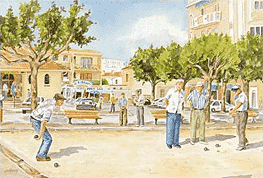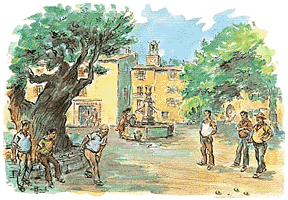| |
 Bicycling •
Boules •
Fishing •
Football •
Golf •
Hiking •
Horseback Riding
Bicycling •
Boules •
Fishing •
Football •
Golf •
Hiking •
Horseback Riding
Pelote •
Skiing •
Spectator Sports •
Tennis •
Volleyball •
Water Sports
Other Sports •
Links to Sports-Related Web Sites
The game of boules, otherwise known as pétanque , is perhaps the sport that is closest to French hearts. Similar to British lawn bowling or Italian bocce , the French version is traditionally played with metallic balls on a dirt surface beneath plane trees, with a glass of pastis at hand. The local boulodrome is a social focal point in southern France.
The object of the game is to throw your balls — usually with somewhat of an arched back-spin — so that they land closer to the small object ball (cochonnet ) than those of your opponent, or strike and drive the object ball toward your other balls and away from your opponent's.
Equipment check
The only really essential equipment is a set of three steel boules. A set costs anywhere from US$5 for a rusty old set you may be lucky enough to come across to US$120 for a competition set. To be legitimate for competition play, a boule must conform to the following specifications:
- Weight: From 650 to 800 grams [1lb. 7oz. — 1lb. 12oz.]
- Diameter: From 70.5 to 80.0mm [2.78" — 3.15"]
| |
|

Fréjus, la pétanque
Watercolor by
Michèle Gallego |
|
| |
A player who specializes in pointing (or placing) should normally favor a small, heavy boule. A heavy boule is slightly more difficult to displace, and a boule of the minimum allowable diameter presents a smaller target to the opposition's shooters. Women and young boys, usually having smaller hands and less arm strength, frequently compromise by selecting a boule that is both light and small.
A shooter should choose a lighter boule for the best chance of success. This may seem surprising, but in fact the decreased momentum of a light boule gives it the best chance of remaining in place after knocking an opponent's boule out of the game (the perfect, and much admired, shot known as a carreau ). A shooter should not use a small boule: a shot that just barely misses with a small boule might have been effective if only that extra 5 mm had been on the radius!
La Boule Bleue of Marseille has a special web page enabling you to pick the right boule for yourself in a step-by-step process.
In choosing a boule, however, perhaps the overriding consideration is "play with what feels comfortable to you."
Desirable but non-essential equipment
A cochonnet
| |
|
| |

La partie de pétanque
by Charles Homualk de Lille |
| |
A proper cochonnet is turned from beech wood and is between 2.5 cm and 3.5 cm (1" to 1-3/8") in diameter. In the South of France, the home of pétanque, a cochonnet can be bought for very small change indeed. It may help to have a brightly-colored cochonnet, especially in conditions of low light, but the rules specify that a cochonnet may be stained but not painted. A cochonnet is not regarded as essential, since in any gathering of pétanqueurs many people can be counted on to provide one. At a pinch, many natural objects can stand in.
A steel tape measure, preferably in centimeters
Usefulness of a tape measure should be obvious: to settle arguments as to which of two boules is closer to the cochonnet.
Very non-essential equipment
As with all sports, equipment shops will try and sell you whatever they can, with the assurance that "you'll find you really need this". The following pétanque trivia is definitely not necessary — although some of it is undeniably fun....
- Peaked cap for playing against the sun
- Calipers for really fine measurements of distance
- Hand-held score keeper (sometimes provided with an image of Fanny on the back)
- Powerful magnet on the end of a string: for those who have trouble bending down to pick up boules
- Special cloth for wiping grit off boules
Here are several sources of pétanque equipment in the USA, U.K., and France:
Pétanque America
P.O. Box 609
Jamestown, NC 27282, USA
Phone: (800) 68-BALLS, (336) 454-4129 ; Fax: (336) 454-4131
Importers of La Boule Obut®.
Playaboule
1001 SW Klickitat Way, Suite 108
Seattle, WA 98134, USA
Phone: (888) 225-2865 ; Fax: (206) 340-5995
Distributor for low-cost leisure series of boules & accessories.
La Boule Bleue
ZI la Valentine, 57 Montée de St-Menet
13011 Marseille, France
Phone: 04-91-43-27-20 ; Fax: 04-91-43-23-70
Manufacturer since 1904. Sets (with carrying case) from €90 to €350.
Obut UK
Up Street, Bardwell, Bury St. Edmunds
Suffolk, IP31 1AA, United Kingdom
Phone or Fax: 01359 250829
Pétanque shop & mail order retailer of Intégrale® Boules and accessories.
Bicycling •
Boules •
Fishing •
Football •
Golf •
Hiking •
Horseback Riding
Pelote •
Skiing •
Spectator Sports •
Tennis •
Volleyball •
Water Sports
Other Sports •
Links to Sports-Related Web Sites
| Boules (Pétanque) Links: |
 |
|
 |
British Pétanque Association
The B.P.A. was founded in 1974 by a small group of enthusiasts and has developed into a full-fledged national organization, served by a permanent staff based at Coventry. There are now 320 affiliated clubs and over 4,000 members in Great Britain. Check out their version of pétanque's origins, which place a similar game in Egypt over 7000 years ago. |
|
 |
Federation of Pétanque - USA
The FEDERATION OF PETANQUE U.S.A., Inc. is a non-profit organization which has as its primary objective the promotion of the sport of pétanque in America. It is a U.S. National Organization member of the International Federation of Pétanque and Jeu Provençal (FIPJP). The Federation acts as a liaison between all pétanque players and all pétanque clubs in the U.S.A. and throughout the world. |
|
|
|
 |
Fédération Internationale de Pétanque et Jeu Provençal
The International Federation of Pétanque and Provençal Game was formed in 1958 at Marseilles with an initial membership comprising seven nations (Belgium, France, Italy, Monaco, Morocco, Spain, & Tunisia). Today, the organization boasts approximately 600,000 licensed players in 46 countries, spanning Europe, North Africa, America (USA, Canada), South Africa (Madagascar), the Far East (Thailand, Singapore, Cambodia, Japan), Australia and New Zealand. The 2001 World Championship was held Sept. 25 - 30 in Monaco. |
|
Fédération Suisse de Pétanque
This site offers an anecdotal account of the origins of "Pied-Tanqué" in 1910. The FSP home page provides listings of Swiss national championships, Sociétés Cantonales (regional clubs), and archives of past events. |
|
Le Langage du Bouliste
In order to be admitted or invited into a group of pétanqueurs , it is essential that one have a grasp of the players' language and the subtleties of the sport. To assist you in that quest, we've provided the principal terms and game strategies here (in French). Also, should you wish to contact any of the seven principal manufacturers of pétanque equipment in France, we've provided a list of their addresses. |
|

|
Pétanque New Zealand
There are more than 50 pétanque clubs active in New Zealand. PNZ provides a directory of all the clubs in 5 regions, plus a notice board, photos, online newsletters, tournament protocol, and information on how to form a new club. |
|
Pétanque.org
Stig Bordsenius of Oslo, Norway, has assembled a wonderful and comprehensive resource on the game of pétanque, including official rules, game tips, news, forums, an extensive database, and much more. |
|
|
|
|
|
|
|
Author: Ian C. Mills © 1998-2008 — All Rights Reserved
Bibliography: Fodor's 99 France, Editor: Natasha Lesser, Fodor's Travel Publications, New York. Paris From $70 A Day, Jeanne Oliver, 1998, Macmillan Travel, A Simon & Schuster Macmillan Company, New York. France 1998 Discovery Guide, French Government Tourist Office, New York. Passport's France Trip Planner & Guide, Emma Stanford, 1994, NTC Publishing Group, Chicago. Let's Go - The Budget Guide to France 1997, Thomas F. Moore, 1997, Let's Go Publications, Cambridge, MA, printed by St. Martin's Press, New York.
Image sources: Pétanque ball and cochonnet (OBUT brand), from Pétanque America (web site); photo of boules in hand and two art postcards, from www.petanque.org.
|
|




